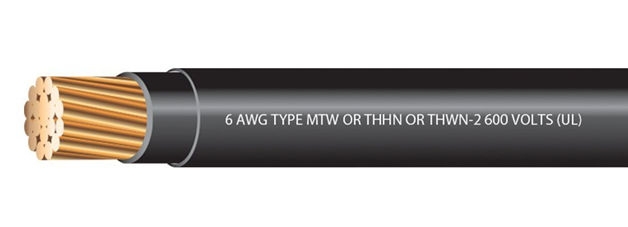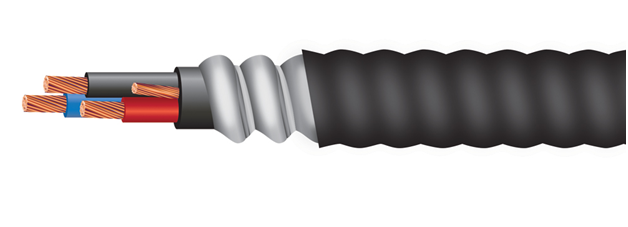More Than Just 6 AWG Wire
4th Aug 2020

If you are not familiar with electrical engineering or electrical wiring and all of the terms and components that get thrown around like water, all of the products and terms you see on our website might look like Greek to you. That’s perfectly normal if you don’t have a background in this type of work, so we’re going to peel back some of the layers and explain what some common terms mean as well as why they are so common. We’ll even take a look at some of the common terms and products you will come across here at EWCS Wire. Our specialty is all things related to electrical wiring, so it behooves us to provide some basic information for some of our readers.
Electrical wire is something that is around us every day and is totally intertwined with everything we do through the course of a normal day. Most of us rely on power even more than we realize, and for that power to get to us it has to be harnessed and then supplied across a power grid over long distances, through inhospitable environments and over rough terrain. Even once it gets to us, its potential must be altered before it can be delivered to most domestic settings. At that point we still rely on the wiring above us, beneath us, and even in the walls in order to perform even the most basic tasks. You couldn’t even be viewing the screen showing you this article right now if it weren’t for the successful wiring in your home, or at least wherever you used to charge the device you are using.
Yet, as we mentioned there are a number of fine points that get glazed over on the daily without ever receiving their due recognition. Read on if you want to learn some more about some of the terms and abbreviations that you’ll see on our website, along with some of the different classes of wire we provide, as well as how they are specialized. As you’ll find, it goes far beyond “6 AWG wire.”
Gauge
We’ll start with wire gauge, since we were bold enough to title this article “More Than Just 6 AWG Wire.” If you have ever worked with wire or cable at all, you have certainly come across the abbreviation AWG, or the term American Wire Gauge. You can see then, where the abbreviation comes from, but perhaps not what it means.
American Wire Gauge is a metric for measuring the cross sectional area of a conductor which then impacts a number of other factors, most notably its ability to carry a current. This system measures the width of a wire and, without getting too technical, now that the smaller the number, the wider the wire. Therefore, the larger the number, the thinner the wire. Larger wire gauge wires tend to be capable of carrying higher currents/ampacities. The thickness and quality of the applied insulation determines the ability of any wire to handle higher voltages.
Wire gauge affects its resistance, or how much the wire will ‘push back’ against the electrons that run along the wire. Greater resistance heats up the wire and makes it less efficient at carrying a current, so larger gauges are preferred for longer distances, whereas narrower wires can be used for carrying the same current over shorter distances.
Aside from the most important thing to remember, which is that a smaller numbered gauge connotes a thicker wire and vice versa, keep the following in mind. American Wire Gauge is used to measure the thickness of a current bearing wire, provided that the wire is not ferrous. Therefore, aluminum and copper wires can be measured using AWG, but not iron. There are separate systems for iron, and iron is hardly ever (if at all) used as a conductor anyway.
Wire Vs Cable
Here’s another thing you’re going to come across on our website and elsewhere that is more confusing than it ought to be so we’ll put it away in short order. If you’ve ever wondered what the difference was between a wire and a cable, you’ve come to the right place, and it’s an easy answer and explanation as well.
So, with no further ado, a wire is a single stranded conductor, whereas a cable is a set of conductors twisted or ‘cabled’together. Therefore, a cable is made up of 2 or more wires. It’s simple enough, but then the only question that remains is, why do it this way?
That is answered easily enough as well. While it is cheaper to produce wire, and usually wires offer less resistance than cable, sometimes a part of the value of a wire or cable is in its flexibility, and a wire is decidedly inflexible. By cabling thin strands together to create a cable, you make the entire assembly not only stronger but more flexible as well.
Voltage
Current is the amount of electricity that flows along a wire in a given amount of time, yet more often than not you will see wires and cables rated according to the voltage they are equipped to handle. So, if current is the amount of electrical energy that flows in a given amount of time (and is measured in amps, by the way) what is voltage, and why does it matter?
Mathematically, voltage equal current multiplied by resistance, which, in somewhat simpler terms, means that voltage is a comparison between the electrical potential of two points. It is a measure of the amount of force that would be required to move a current between two points. Voltage therefore is a potential measurement, and it matters because it represents a relative measurement of the difference between two areas containing a charge.
That is why wires are typically rated according to voltage; because voltage accounts for current and resistance. Theoretically, if a wire offered no resistance, it could carry a much higher electrical current, but because wires have mass and mass offers electrical resistance, the voltage rating is the measurement of what current that wire can carry at its current resistance without deforming, melting, shorting or starting a fire.
600 volt wire is so common in building applications because most residential service is 110 or 200 volts. Providing enough insulation to rate a cable at 600 Volts allows for a safety factor in almost any application. Even commercial use is commonly no higher than 440 volts, so a 600 Volt rated cable will serve economically in most residential and commercial applications.
Here at EWCS Wire, however, we offer plenty of specialty products, and some of them are wires rated to much higher than normal voltages. For example, we offer a line of wires for special applications that are rated to 2000 volts for carrying a much higher current.
Our 2000 volt rated diesel locomotive (DLO) cable that can be used as a motor lead or in other industrial settings where a heavy duty cable capable of carrying a high current is necessary. Our 2000 volt DLO cables are relatively flexible and extremely tough, resistant to oil and grease, water, sunlight, abrasion and even ozone. They are even individually tinned to better resist corrosion, but we will address that more closely in our section on marine cable.
Color
Seeing all of the different colors in cable you may have wondered if there was some technical reason for the coloring of cable, and why come cables are uninsulated as well. If your question is, “does insulation coloring matter,” the answer is, well, yes and no.
Like all things, it depends. Usually electricians and engineers use different colors of insulation, where the wires are otherwise identical, to keep leads separate. However, there are a few conventions you can follow with respect to color to help make sense of things.

First off, if a wire is uninsulated, that is, bare copper, it is almost certainly a ground wire. Ground wires are critical safety measures for electrical circuits. In the event of a fault, a ground wire provides a current route back to its source to prevent issues arising from the fault and as a safeguard against electrical shocks. Ground wires are bare because, under normal circumstances, they have zero electrical potential; they are only there as a safety measure.
If a wire is insulated, you may be able to discern some meaning from the color of the insulation. Wires with white insulation are usually not used as hot leads, and wires with green insulation are sometimes used as grounds, although as explained above grounds are typically bare.
Beyond that, the insulation color doesn’t necessarily mean too much, at least universally. At that point, the main purpose of the color of the insulation is to allow the electrician or engineers working on a project to distinguish between the different wires being used in separate circuits.
Insulation
Since we took some time to address the colors of the insulation that you will find with many different types of wire, here’s a bit more information on some of the relatively esoteric terms you will see ascribed to different types of insulation.
On our website you are likely to come across wires that are labeled at THHN, which, unless you are savvy to this market, is just a jumble of letters. Really, it relays some information about the insulation and its suitable uses and strengths.
THHN, for example, connotes that the insulation is made from thermoplastic (T), is resistant to high heats (HH) and is coated in nylon (N), as nylon is useful in repelling some hydrocarbons like gas and oil. This makes wires of this sort slightly more resilient than they would otherwise be. Are they as tough as alternatives with other polymers and plastics used as their insulation.
A similar styling is THWN, some of the meaning of which you can probably deduce after your exposure to THHN insulated wire. THWN wire, somewhat similarly to THHN, is made with a thermoplastic insulation, is heat resistant (although not as much as the former), is suitable for use in wet locations (W) and is nylon coated for the above reasons. Does that make it as tough as XLP wire? Not at all.
Since we mentioned it, that’s another acronym you’re going to come across on our site, especially if you are shopping for specialty wire, and it’s one you should learn in that event. We have some wires that are insulated with XLP, which is also known as cross-linked polyethylene. XLP insulated wires & cables are commonly used in industrial and commercial applications.
Only certain specialty wires and cables for use in extreme environments have this type of insulation for the specific protection it affords. Regular polyethylene suffers from some problems, such as stress fractures and impact fracturing as well. By cross linking it, it becomes impact resistant as well as stress fracture resistant and abrasion resistant on top of all of that. In addition, the cross-linking process mitigates other problems such as excess hardness and rigidity. In one fell swoop it produces a material that is flexible and extremely tough, which is exactly why you can find this type of insulation with certain types of wires like our Teck armored cable that is designed for use in extreme locations.

Tray vs Conduit
You will also see cables on our website that are labeled as suitable for use as tray cables. Simply, tray cables offer an alternative to conduits. Conduits are metal pipes that carry cables and wires, typically over long distances. They prevent electrical interference and also protect the cables or wires against environmental factors like sunlight.
Unfortunately, pullingcables through conduit is very difficult and expensive, and on top of that conduits sometimes present problems of overheating. For that reason, trays have become a popular alternative - it is easier to lay cable along a tray, easier to maintain the cables once they are laid, and on top of that, trays allow heat to dissipate more readily.
These sections address some of the fine points of detail regarding some of the technical terms and jargon that go far beyond “6 AWG wire” that you will find on our website here at EWCS Wire. We realize, however, that there are many more terms on our website that might raise some questions, along with many categories of specialty products that could raise questions as well.
If you are looking through our website and would like some additional information to clarify the use of a product or how its features make it suitable to that use, give us a call at 800-262-1598 and we’d be more than happy to answer them.
